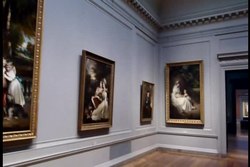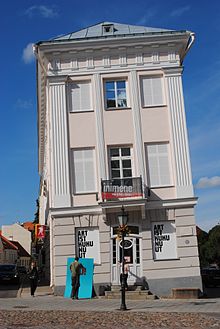Art museum
![]()
This article deals with the concept of art museum concrete art museums are listed in the list of art museums
![]()
This article or section is still missing the following important information:
This article is an overview article, not a lemma for a museum list. Lacks a detailed account of the history of the institution and exhibition concepts. It lacks an account of the architecture of art museums as icons and in relation to their special requirements. Art museums as urban, civic and personal representation belong explained and their role in urban development (Museumsufer, Bilbao effect etc.). Visitor research is missing (there are great studies on the declining and partly forced declining length of stay per work etc.). It's more work than mindless lists, the content of which is also partly wrong, but it has to be done.
Help Wikipedia by researching and adding them.
An art museum is a public or private museum that collects, archives, and exhibits works of art by one or more artists. Many state art museums conduct art historical research and strive to restore works of art.

Play media file National Gallery of Art, Washington DC.
Art Museum Types
In its museum statistics, the Berlin Institute for Museum Studies counts as belonging to art museums, museums with the following collection areas: Art and architecture, arts and crafts, ceramics, church treasures and ecclesiastical art, film, photography.
If an art museum is only concerned with the oeuvre of a single artist, it is referred to as an artist's museum. An art museum that only collects and exhibits paintings is also called a picture gallery. In modern times, however, a gallery is usually understood to mean a salesroom for art objects. In contrast to an art museum, a gallery serves to sell the works on display to public or private collectors. There is no legal protection of the term art museum, so that anyone can use this term.

Exhibition building of the Tartu Art Museum in Tartu, Estonia
History
In the Middle Ages, ecclesiastical institutions collected valuable liturgical equipment and works of art. The collected objects form the basis for today's cathedral treasure museums. Since the 14th century, European princely houses established art collections. Early forms are found in the 18th century mainly as princely collections, cabinets of art and rarities.
In 1661, with the donation of the "Amerbach Cabinet" of a wealthy patron to the city of Basel, the first public art collection in Europe was established, which was to lay the foundation for what was later to become the Kunstmuseum Basel, the most important and largest museum of its kind in Switzerland. In this way, an important foundation stone was laid in Basel for what is known as patronage, where wealthy and influential citizens of a city support the promotion of art for the benefit of the community, either anonymously or under their full names. The age of revolution and changes in civic orders from 1789 to 1830 led to a series of new museums and a reorientation in which art was seen as the property of the nation, as can be seen, for example, in the history of the Louvre in Paris. With the strengthening of the bourgeoisie in the 19th century, municipal art collections then emerged throughout Europe. Of particular note here is the case of the city of Berlin, where the established bourgeoisie, under the guidance of art historians, began to take an interest in the then still new direction of Impressionism, and as a result numerous paintings and pictures subsequently came into public ownership.
The period from 1830 to 1880 ("museum age") is considered to be the actual founding period of art museums, followed by art museums of the modern era.
From the point of view of museums and urban planning, the following new museums were and are significant: the Uffizi (Medici collection) in Florence in 1743, the extension of the Museo Pio-Clementino by Pius VI in 1775 (today in the Vatican Museums), the Musée Napoléon in Paris in 1800 (today the Musée du Louvre), the Museo Pio-Clementino in Rome in 1775 (today in the Vatican Museums). In 1775, Pius VI extended the Museo Pio-Clementino (now in the Vatican Museums); in 1800, the Musée Napoléon in Paris (now the Musée du Louvre); the Rijksmuseum in Amsterdam, which was founded in 1808 but was not given a museum building until 1877/85 by the architect Pierre Cuypers; the Glyptothek in Munich, which was initiated in 1816 by Crown Prince Ludwig of Bavaria but was not completed until 1830 according to plans by the architect Leo von Klenze; the Städelsche Kunstinstitut, founded in 1817 and given its own museum building in 1878, Städel for short, in Frankfurt am Main, the Museo del Prado in Madrid in 1819, the Wallraf-Richartz-Museum in Cologne in 1824, the National Gallery in London, founded in 1824 but not built until 1832 to 1838, the Altes Museum in Berlin, built by the architect Karl Friedrich Schinkel from 1825 to 1828, the Alte Pinakothek in Munich in 1836, the New Hermitage in St Petersburg, also built by Leo von Klenze from 1839 to 1852.
These were followed by the Museum Ferdinandeum in Innsbruck from 1842 to 1845, the Kunstmuseum Basel from 1844 to 1849, the Neue Pinakothek in Munich built from 1846 to 1853 according to plans by the architect Friedrich von Gärtner, the Kunsthalle Bremen built from 1847 to 1849, the Gemäldegalerie Alte Meister in the Sempergalerie in Dresden opened in 1855, the Smithsonian Institution in Washington, D.C. in 1855, the Kunsthalle Hamburg from 1863 to 1869, the Tretyakov Gallery in Moscow opened in 1893 but dating back to 1851. the Kunsthalle Hamburg, built between 1863 and 1869, and the Tretyakov Gallery in Moscow, opened in 1893 but dating back to 1851.
From 1867 to 1876 the National Gallery in Berlin (today the Old National Gallery) was built, followed by the Art Institute of Chicago in 1879, the Kunstmuseum Bern in 1879, the Metropolitan Museum of Art in New York at its present location in 1880, the Tate Gallery in London in 1897, the Pushkin Museum built in Moscow from 1898 to 1902, and the Museum Folkwang in Hagen in 1902.
In Japan, the first art museum was opened in Tokyo in 1877 and designated with the specially created word "bijutsukan". Initially, this was a temporary sales exhibition for contemporary art modeled on the Paris Salon. Institutions that not only exhibit art but also collect it did not emerge in Japan until after the Second World War.
In the 20th century, new exhibition concepts then developed, e.g. white cube and art museum architecture oriented to it, in the 21st century up to the abandonment of premises as virtual art museums.
Italy
In Florence, the Medici collected not only ancient works of art, but also contemporary art, and with their acquisitions created what is now the core collection of the Uffizi. The archway on the upper floor of the Uffizi, the galleria, is the origin of the term gallery to describe painting galleries and art museums.
Austria and Czech Republic
Emperor Rudolf II. (HRR) appeared in Prague as an important art collector and patron. His art collection is legendary and was the largest of its time. After the plundering of Prague in 1648, it was scattered all over the world. Today, part of this art collection forms the basis of the Brueghel Collection of the Kunsthistorisches Museum in Vienna.
Some of the works from the Rudolphine collection remained in Prague after all and are now in the possession of the Prague Castle Picture Gallery and the Prague National Gallery, which was founded in 1796 by the Czech nobility as the Picture Gallery of the Society of Patriotic Friends of Art.
Germany
The first independent gallery building was the Gemäldegalerie Düsseldorf, which was erected between 1709 and 1712 and thus created an independent type of art museum.
Russia
As an absolutist ruler, Tsarina Catherine II founded the Hermitage in St Petersburg in 1764.
France
The secularization of ecclesiastical possessions initiated by Napoleon Bonaparte brought an increase in art objects to the art museums (e.g. Musée du Louvre).

Basel Art Museum, since 1661 it has housed Europe's oldest art collection open to the public.
Search within the encyclopedia